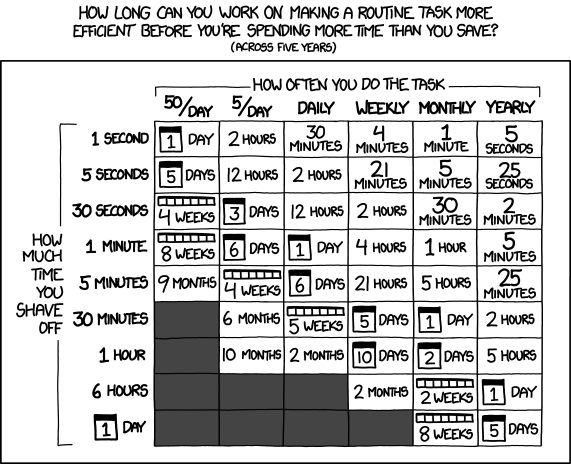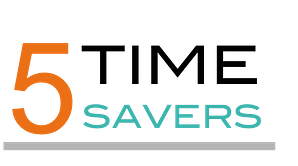I'm preparing to give a session on productivity for our faculty in the Fall. The first challenge I have is trying to come up with a name for the talk. The term, productivity, tends to come with its own set of challenges. It can bring to mind the idea of trying to gauge some type of return-on-investment model for faculty's work. Those of us who see this work as a calling don't tend to enjoy having our efforts reduced down to a set of inputs and outputs.
The reason our faculty development committee decided to offer the session is simple. Productivity-related topics were ranked among the highest on a needs analysis survey we completed in our planning process for our largest professional development event of the year. Telling me that my colleagues were interested in learning how to increase their effectiveness and efficiency brought me great joy. It was only later that I realized just how challenging it would be to attempt to meet such a broad spectrum of needs and interests. Productivity is increasingly becoming more important to our society and even science is getting behind the need to be more efficient and effective:
Like much of academia, our community is full of diverse perspectives and approaches to what is often referred to as personal productivity (“personal,” as opposed to team or organizational efficiency and effectiveness). More of us professors are carrying around smart phones these days, though there are still a few who communicate exam grades by posting spreadsheets on their office doors with student ID numbers and the respective earned points. Many of us lament about how distracted students are when using laptops in class, while others expect the entire class to be “wired” throughout all the class sessions. There's even the claim that our brains are getting addicted to the internet, though fortunately, there's also a prescribed cure.
While I want to leave room for individual differences, my goal is still to communicate a core set of foundational principles that any system or approach must have in order to be considered adequate. Whether leveraging technology, or more traditional systems for organization, the following criteria are among those I expect all tools that I use to include. Any part of my personal productivity system must be:
Ever-present
My Mom was one of the longer hold-outs I know of in my life who kept carrying a paper calendar and to do list with her. She does search and rescue with her dogs and this practice started to become increasingly challenging as slips of papers that contained important tasks or phone numbers wound up being inadvertently left on the side of a hill somewhere. She was vigilant about using electronic equivalents, since the syncing processes of the past were complex and unreliable.
When my husband and I introduced her to the Mac and she realized how easy it now was to sync her calendar, to do list, and contacts between all her devices, she left her paper forms of organization behind forever (well, except for password management, but we are working one step at a time with her).
Any system of organization must be able to be carried with us at all times. Our personal and work lives are too intertwined (especially as faculty members) to have separate systems for each aspect of our lives.
Simple
Any new tool that I add to the mix needs to be simple to use, at least to get started. I tend to be an early adopter on most things, though I recognize that I am in the minority.
My approach now is to always use tools that are simple to use, at least to get started using. One area where this has been demonstrated in the tools that I use is with the task manager called Remember the Milk (http://www.rememberthemilk.com). It is a web-based tool that also has the requisite apps for various smart phones (including iOS and Android devices). Getting started is as easy as creating an account and starting to enter tasks. As I have discovered more about the tool, I have improved upon the most obvious of features and adjusted my uses.
This simplicity factor is illustrated well in the growing popularity of the iPhone/iPad app called Drafts. On the most basic level, this app opens a blank document every time you open it and gets you started on your intended task (writing something) in the fastest manner possible. Once you learn more about the app and grow in your comfort level, you can create all sorts of shortcuts, or make use of creative solutions that have been developed by others who also use the app. I am in the process of incorporating Drafts into my workflow.
As I consider whether or not to add something new to my toolkit, I have taken to asking two questions. First, I want to know the primary intended purpose of the tool. Then, I want to know if I can figure out how to easily perform the intended purpose without reading any instructions or watching any tutorials. If the answer to the second question is yes, then it is ready to move into more careful analysis of whether or not I will find it to be a beneficial part of my personal productivity toolset.
Time-saving
I'll be the first to admit that this is the one that I have the most trouble with. I have been known to invest hours of time into something that realistically won't save me but a few minutes a month. Sometimes, my supposed time-saving approaches wind up with me in the negative side of the calculation.
Fortunately, someone else has already done the math for us, in order to determine if investing the time is going to ultimately be worth it or not.

xkcd.com is a site that offers webcomics of “romance, sarcasm, math, and language.” In this comic, they use math to illustrate just how long we should spend on making a task more efficient before we have invested more time than it is going to save us.
Remember that the little stuff can really add up. Take something we do as frequently as copy and paste on our computer. Is there a way you can tweak your approach to that task to save you time in the long run?
I started using the TextExpander application on my Mac a year ago. It is a tool that allows you to store frequently-used text, graphics, or other pieces of data and create a shortcut for entering it. With students, I find myself answering the same questions repeatedly. TextExpander allows me to save those FAQs and only have to type a few characters and then have the short text get expanded to the series of paragraphs that contain my answer, for example.
Students contact me often about internships, as I am the instructor of record for that course. I type in the letters VU, followed by the word internships, and the introduction to how the course is taught, followed by a website link gets entered into the email. They even have an iOS app, so that I can use the same commonly-used text “snippets” on my mobile device.
Complementary
Since I have invested so much time and effort into finding systems that work well for me, anything new that gets added into my tool set needs to be complementary to others that I use. Any applications that require syncing services should use Dropbox, or at the very least, iCloud.
Learning curves can be significantly reduced when the systems you use work with one another. Evernote has been becoming more of a central tool in my organizational toolset, particularly given the large number of apps and devices that work with it. My latest LiveScribe pen saves its pencasts inside of Evernote. My preferred hand-written note-taking app links with Evernote. As I indicated above, I'll soon be incorporating Drafts into my workflow and it can send to Evernote, including specifying the notebook to send it to and what tags and other metadata to add.
How about you? What characteristics do you look for when deciding if a tool is going to be integrated into your workflow and approaches? Are there any other tools that I didn't mention that fit into the characteristics of being simple, time-saving, and complementary?

